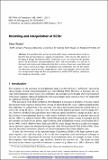Files in this item
Modelling and interpretation of SEDs
Item metadata
| dc.contributor.author | Woitke, Peter | |
| dc.date.accessioned | 2015-10-02T16:10:02Z | |
| dc.date.available | 2015-10-02T16:10:02Z | |
| dc.date.issued | 2015-09-23 | |
| dc.identifier | 220993214 | |
| dc.identifier | 1d3ebea5-c032-40b1-9c60-018fcff478d6 | |
| dc.identifier | 84960112482 | |
| dc.identifier | 000372793100006 | |
| dc.identifier.citation | Woitke , P 2015 , ' Modelling and interpretation of SEDs ' , EPJ Web of Conferences , vol. 102 , 00007 . https://doi.org/10.1051/epjconf/201510200007 | en |
| dc.identifier.issn | 2100-014X | |
| dc.identifier.other | Bibtex: urn:d965ac09cfd8cf0b1f54ba26ea999bf5 | |
| dc.identifier.uri | https://hdl.handle.net/10023/7589 | |
| dc.description | The research leading to these results has received funding from the European Union Seventh Framework Programme FP7-2011 under grant agreement no 284405. 6th Lecture from Summer School “Protoplanetary Disks: Theory and Modelling Meet Observations” | en |
| dc.description.abstract | Circumstellar disks are mostly detected by larger continuum fluxes in the infrared to mm spectral regions as compared to naked stars (a flux excess). The analysis of the Spectral Energy Distribution (SED) of that flux excess was crucial for the development of the first theories about protoplanetary disks, and even nowadays, it is still one of the major tools to physically characterise the disks in terms of their mass, inner holes and gaps, vertical extension & shape, dust properties, and evolutionary state. In this chapter, we will review some of the early simple theories, show some examples, discuss the influence of typical disk shape and dust size parameters in modern SED analysis, and discuss how degenerate the results can be. | |
| dc.format.extent | 24 | |
| dc.format.extent | 2768906 | |
| dc.language.iso | eng | |
| dc.relation.ispartof | EPJ Web of Conferences | en |
| dc.subject | QC Physics | en |
| dc.subject | T-NDAS | en |
| dc.subject.lcc | QC | en |
| dc.title | Modelling and interpretation of SEDs | en |
| dc.type | Journal article | en |
| dc.contributor.institution | University of St Andrews. School of Physics and Astronomy | en |
| dc.identifier.doi | https://doi.org/10.1051/epjconf/201510200007 | |
| dc.description.status | Peer reviewed | en |
This item appears in the following Collection(s)
Items in the St Andrews Research Repository are protected by copyright, with all rights reserved, unless otherwise indicated.

